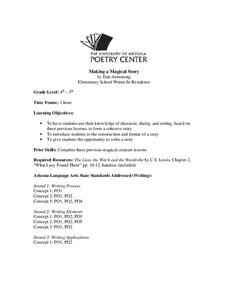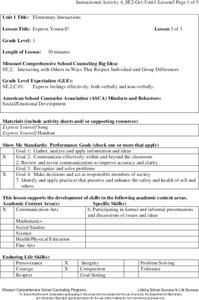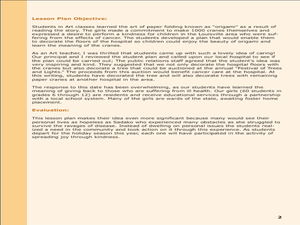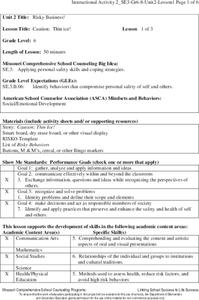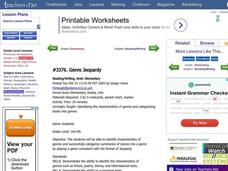Core Knowledge Foundation
Weather or Not, Seasons Change
Embark on a year long investigation of the seasons with this 10-lesson earth science unit. After being introduced to different types of weather and the tools used to measure it, young scientists perform fun hands-on activities that...
Curated OER
Making a Magical Story
Fourth and fifth graders use their knowledge of developing character, dialogue, and setting to produce an original story. An excerpt from The Lion, The Witch, and The Wardrobe is used as inspiration to get everyone's...
Curated OER
Modernizing a Traditional Irish Folktale
Students write their own folktales based on "Cathal O'Cruachan and the Cowherd." In discussions they examine the animal symbolism in the story, as well as the characters, events, problems, and solution. With partners, they select...
Missouri Department of Elementary
Express Yourself!
Encourage scholars to express themselves with help from an engaging song. Sung to the tune of "London Bridge is Falling Down," participants sing phrases that offer tips for dealing with emotions—sad, happy, worried, proud, mad, and...
Curated OER
Elaborating the Main Idea, Using Supporting Details
A desk is used as a visual analogy to construct the main idea and supporting details in a story. The top of the desk is the main idea, and each of the four legs provides supporting details. The legs of the desk provide support for the...
Curated OER
Little Cloud
Students create "little clouds" after reading the story "The Little Cloud" by Eric Carle in this cross-curricular Art and Language Arts lesson for the early-elementary classroom. The author suggests using this with a "Raindrop Picture"...
Curated OER
"Ancora Imparo" (Still I Am Learning)
Students study the Italian Renaissance, its impact, and origin. In this Italian Renaissance lesson, students study the Renaissance via the ancient civilizations and political geography of various countries. Students study the art prior...
Curated OER
Origami Paper Cranes
Students complete cross-curricular activities to study the culture and humanity in Japan. Students read the book Sadako and the 1000 Paper Cranes and complete social studies and art lessons related to the book as well as develop an...
Missouri Department of Elementary
An Apple a Day
Three apples—green, red, and rotten—exemplify character traits, negative and positive. Following a discussion about the classroom community, scholars complete an apple-themed worksheet that challenges them to read each trait, color it...
Missouri Department of Elementary
Caution: Thin Ice!
Sixth graders listen to a story titled "Thin Ice!" then partake in a whole-class discussion asking and answering questions about what was read. Scholars brainstorm risky behaviors in preparation for a game of RISKO—a game similar to...
Curated OER
Comparing Different Types of Corn
Students explore different types of corn. In this science lesson, students compare sweet corn, field corn and Indian corn. Students gather specific information. Additionally, students discuss their findings.
Curated OER
Genre Jeopardy
Students participate in a game-like format to identify characteristics of genres. They categorize stories into genres bases on story summaries after a class discussion of the characteristics.
Library of Congress
Stars, Stripes and Symbols of America: Comparing Our Flag, Past and Present
Your young historians will compare and contrast the details of the American flag today with an an image of the nation's flag from the post-Civil War era, and identify the flag's importance as a national symbol through analysis...
Middle Tennessee State University
Who's Afraid of the Big Bad Wolf? A Comparison in American Culture
As part of their study of the Progressive Era, class groups examine a 20th century version of "The Three Little Pigs" through a New Era lens and identify how ideals such as the value of hard work, creativity, and problem solving,...
Curated OER
Grizzly Habitat
Students find areas on playground where they would live if they were a grizzly bear, share their reasons for their choice, talk about habitat areas, and choose their sites again, based upon new information.

